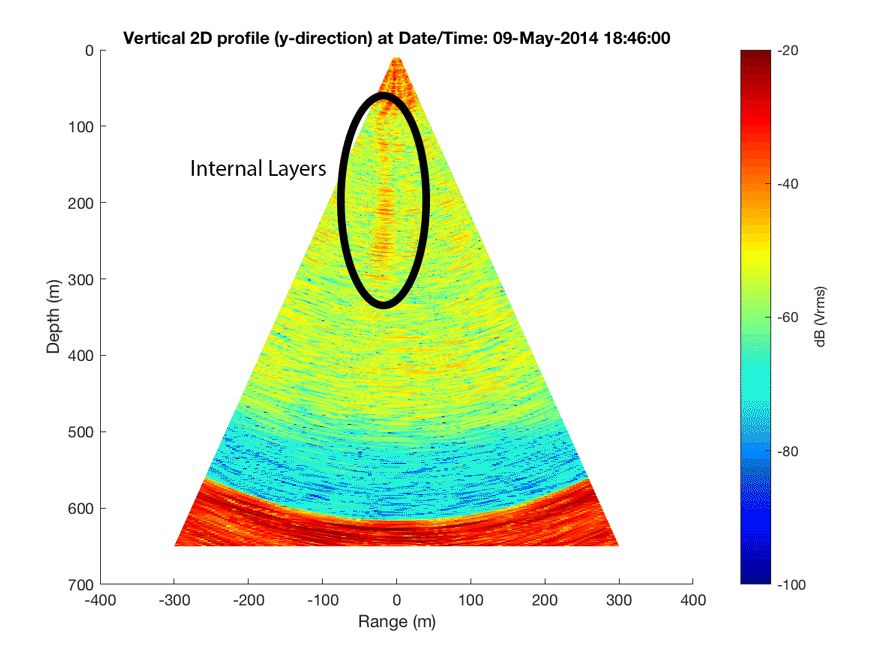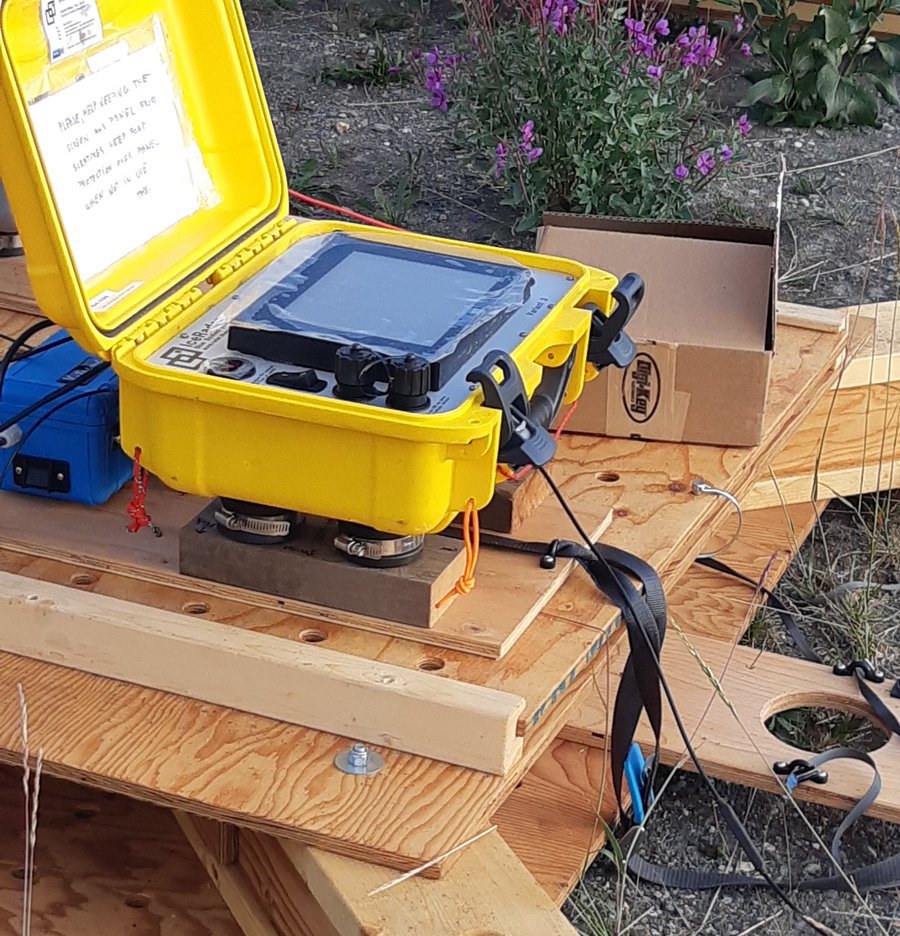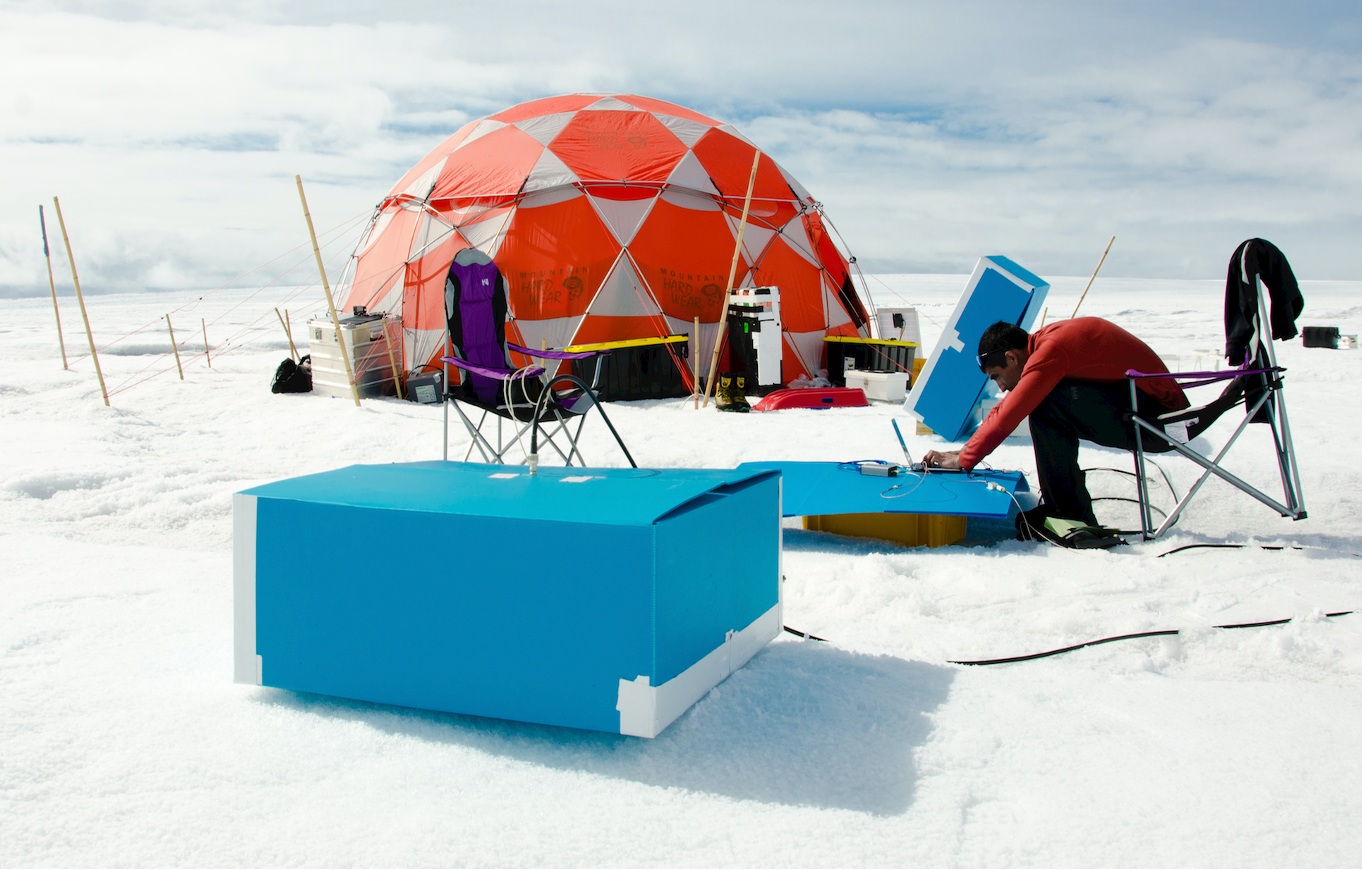Phase-Sensitive Radar
Conventional ice-penetrating radar sounders are pulse systems that provide single snap-shots of what's happening beneath the ice sheet surface. However, many critical glacial processes, such as meltwater drainage, ice deformation, ice-shelf basal melting, and crevasses formation, can evolve quickly over time. To understand these time-varying mechanisms, a new class of frequency-modulated continuous-wave ice-penetrating radar sounder was recently developed by the British Antarctic Survey in the U.K. This new radar system, known as autonomous phase-sensitive radio-echo sounders (ApRES), has been a game-changer in understanding ice-ocean interactions and ice flow deformation.
Our research focuses on using ApRES to investigate glacial hydrology and ice sheet thermal structure in Greenland. We have an ongoing project in Helheim Glacier, East Greenland, funded by the Heising-Simons Foundation to set up networks of ApRES along with other field instruments, including GPS, fiber optics, electromagnetic, and potentially seismic, to study the importance of englacial firn aquifer. We also work with the ERC-funded RESPONDER team on a project at Store Glacier, West Greenland, to analyze ApRES observations and examine the connection of meltwater drainage from the top to bottom of the ice sheet and the year-long variations of the glacier's hydrologic system. These year-long measurements of the ice sheet subsurface enabled for the first time by ApRES are very exciting and will be helpful to develop new theories about ice sheet hydrology and other internal processes.
Collaborators: Kristin Poinar (Buffalo), Colin Meyer (Dartmouth), TJ Young (Cambridge), Poul Christoffersen (Cambridge), Brynn Hubbard (Aberystwyth), Samuel Doyle (Aberystwyth)
Current Students: Renée Clavette (EAS MSc.)

Selected Publications
Scattering Power Analysis
Radar bed reflectivity (essentially brightness) is a valuable metric to study the material properties of the ice-sheet bed, such as the distribution of subglacial lakes, the transition between grounded and floating ice. However, many of important processes that govern ice flow and ice sheet stability aren't just related to "where" water is located, but also "how much" and "how fast" these material properties of the ice sheets are changing. To do that, we have to go beyond traditional radar reflectivity analysis and also examine other metrics that describe the radar scattering power, such as specularity coefficient and cross-track energy.
Our work seeks to advance the frontier of ice-penetrating radar sounding analysis by developing methods to combine reflectivity and scattering power metrics to extract additional information about the ice sheets. By jointly analyzing these radar metric, we can obtain a more robust constraint on the amount of water storage within the ice sheet, examine roughness changes related to ice sheet geomorphology, which is a historically understudied area in glaciology.
Collaborators: Riley Culberg (Stanford), Dustin Schroeder (Stanford), Duncan Young (UTIG), John Paden (CReSIS)
Current Students: Rohaiz Haris (ME undergrad)

Selected Publications
Bistatic Radar Application
Conventional ice-penetrating radar sounders use a monostatic configuration in which the transmitter and receiver are collocated. While this setup is good for retrieval of ice sheet thickness, monstatic radar is not sufficient for resolving ice sheet temperature profiles, and other glacial properties such as englacial water storage and isolating the thermal and hydrology effects on radar power independently. To achieve this, a new bistatic ice-penetrating radar system that can recover weak echoes at large antenna separations is necessary.
Our group works closely with radar electrical engineers, in particular with Nicole Bienert (Stanford-JPL) who has developed the bistatic radar instruments and processing chain that can resolve small temperature signals with high fidelity. We have a field project in East Greenland that will explore the opportunity for applying bistatic radar to perform glacial tomography and ice temperature inversions. This joint engineering-glacial geophysics project is an exciting new research direction for our group and will continue to grow with more GT-based engineering collaboration in the future. Stay tuned for more publication and research update in this area.
Collaborators: Nicole Bienert (Stanford-JPL), TJ Young (Cambridge), Elisa Mantelli (Princeton), Dustin Schroeder (Stanford)

Selected Publications
Passive Radar Application
The lack of multiannual observations of the subsurface ice sheet is one of the greatest limitations in understanding how glacial processes critical to ice sheet dynamics and stability may vary with a warming climate. Unlike the ice sheet surface, which remote sensing observations can continuously monitor, the ice sheet englacial and subglacial conditions can only be effectively measured by radar sounding and other geophysical methods. However, conventional active radar sounders are too power-intensive to provide continual data of the ice sheet subsurface.
Passive ice-penetrating radar technology, developed by Sean Peters (MIT Lincoln Lab), offers a potential new tool that shows promises to provide cost-effective, extended time-series measurements of the cryosphere. Our group collaborates with Sean Peters to explore the application of passive radar sounders in the Greenland Ice Sheet, particularly in providing long-term observations of ice thickness changes, englacial water storage, and basal melting.
Collaborators: Sean Peters (MIT Lincoln Lab), Dustin Schroeder (Stanford), Mark Haynes (NASA JPL), Andrew Romero-Wolf (NASA JPL)

